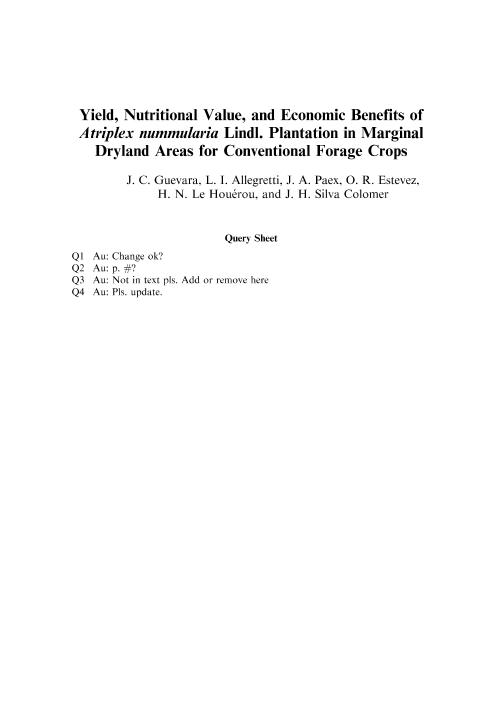Artículo
Yield, nutritional value, and economic benefits of Atriplex nummularia Lindl. plantation in marginal dryland areas for conventional forage crops
Guevara, Juan Carlos ; Allegretti, Liliana Inés; Paez, J. A.; Estevez, Oscar Roberto
; Allegretti, Liliana Inés; Paez, J. A.; Estevez, Oscar Roberto ; Le Houérou, H. N.; Silva Colomer, Jorge Horacio
; Le Houérou, H. N.; Silva Colomer, Jorge Horacio
 ; Allegretti, Liliana Inés; Paez, J. A.; Estevez, Oscar Roberto
; Allegretti, Liliana Inés; Paez, J. A.; Estevez, Oscar Roberto ; Le Houérou, H. N.; Silva Colomer, Jorge Horacio
; Le Houérou, H. N.; Silva Colomer, Jorge Horacio
Fecha de publicación:
10/2005
Editorial:
Taylor & Francis
Revista:
Arid Land Research And Management
ISSN:
1532-4982
Idioma:
Inglés
Tipo de recurso:
Artículo publicado
Clasificación temática:
Resumen
This study assessed: (a) the total aerial and browse biomass of Atriplex nummularia Lindl. (saltbush) on ungrazed 9, 21, and 33-month old shrubs; (b) some relevant nutritional parameters for browse: and (c) the economics benefits of saltbush plantations in terms of cost ratios of energy and protein of saltbush vs. alfalfa, Medicago sativa L., hay. Three-month old nursery-grown speedlings were hand transplanted into a furrow bottom at a spacing of 1 x 2 m in an area with shallow (1-1.1 m deep) and moderately saline (4.6 dS m -1) water table. Seven rows of about 110 plants each were established. Linear regression equations of shrub volume on total and browse biomass were estimated. Nutritional parameters were determined for 33-month old shrubs. To estimate the cost of saltbush plantation, the following scenarios were considered: (a) poorly and adequately managed plantations (10- and 30-year life-span, respectively), (b) saltbush browse yields from 1.0 to 6.5 Mg D M ha-1 year-1, and (c) two management systems (cut-and-carry for pen feeding and direct browsing). For alfalfa crop, cultivated under irrigation, the life-span was four years and the yield was 10 Mg D M ha -1 year-1 from year two onward. Costs through the life-span of the two crops were discounted at present value using a 12.0% discount rate. Browse biomass was about 0.4, 0.8, and 1.4 kg D M shrub -1 for 9-, 21-, and 33-month old shrubs, respectively, or 6.5 Mg D M ha-1 year-1 for the oldest saltbush plants, corresponding with the surviving 4,665 shrubs ha-1. Mean values of nutritional parameters were: organic matter, 74.7%; in vitro organic matter digestibility, 47.0%; ash, 25.3%; crude protein, 13.6%; Na, 5.6%; and Cl, 7.7%. Saltbush proved to be a highly productive species in areas that are marginal or unsuited for conventional crops such as alfalfa. The cost ratio saltbush/alfalfa hay for metabolizable energy and crude protein was lower than one for all the scenarios related to life-span and management systems of saltbush when saltbush yield was higher than 3.0 Mg D M ha-1 yr-1. The overall mean cost ratio saltbush/alfalfa hay for crude protein and metabolizable energy for all the scenarios was 0.22, considerably lower than that considered in our hypothesis.
Archivos asociados
Licencia
Identificadores
Colecciones
Articulos(IADIZA)
Articulos de INST. ARG DE INVEST. DE LAS ZONAS ARIDAS
Articulos de INST. ARG DE INVEST. DE LAS ZONAS ARIDAS
Citación
Guevara, Juan Carlos; Allegretti, Liliana Inés; Paez, J. A.; Estevez, Oscar Roberto; Le Houérou, H. N.; et al.; Yield, nutritional value, and economic benefits of Atriplex nummularia Lindl. plantation in marginal dryland areas for conventional forage crops; Taylor & Francis; Arid Land Research And Management; 19; 4; 10-2005; 327-340
Compartir
Altmétricas



